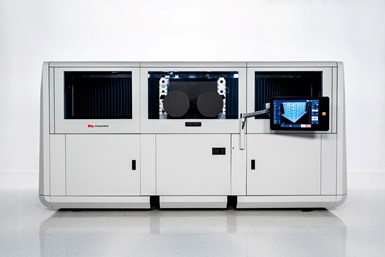Desktop Metal’s P-50 Metal 3D Printer for Mass Production
IMTS 2022: The company says the printer’s bidirectional, area-wide printing enables production quantities of up to millions of parts per year at costs competitive with conventional mass production techniques.

Photo Credit: Desktop Metal
Desktop Metal developed its P-50 metal 3D printer is designed to meet the challenges of speed, quality and cost. The printer is designed to mass produce high-performance metal parts with repeatability.
With a build box of 490 × 380 × 260 mm (19.2″ × 15″ × 10.2″) and the ability to achieve speeds up to 100 times those of prior powder bed fusion additive manufacturing technologies, the bidirectional, area-wide printing of the P-50 enables production quantities of up to millions of parts per year at costs competitive with conventional mass production techniques, according to the company.
The 3D printing platform is said to support a materials library that includes 10 qualified metal alloys, including commercially pure copper and stainless steels like 17-4PH. Additional metal alloys are currently in active development. Desktop Metal credits the P-50’s repeatability to the printer’s anti-ballistics technology, print bar redundancy and live optical print bed inspection
Related Content
-
Formlabs Expands SLA/SLS Ecosystem With New Materials, Postprocessing Tools
The new hardware, software and materials are designed to streamline postprocessing and unlock new workflows.
-
AM Trends to Explore at IMTS 2024
Registration is now open for IMTS 2024 — the additive manufacturing event where creators, builders, sellers and drivers of manufacturing technology come to connect, be inspired, and find solutions.
-
3D Printing Solutions to Support Investment, Sand Casting
3D Systems is highlighting a design strategy for better investment casting patterns, as well as a new machine suitable for the production of patterns for sand casting.












